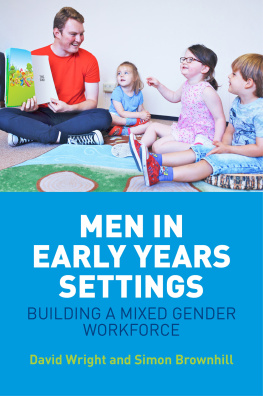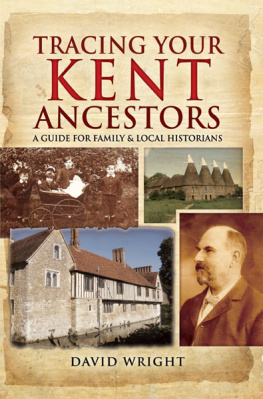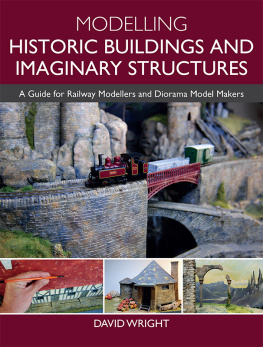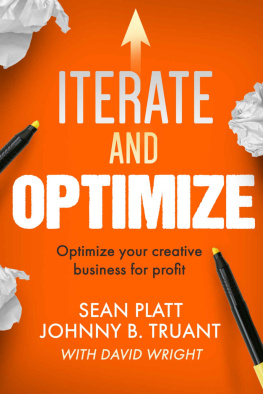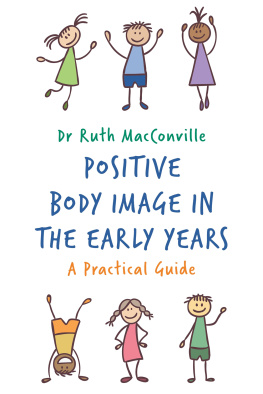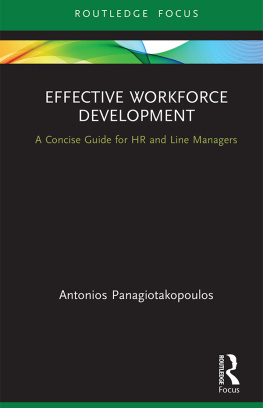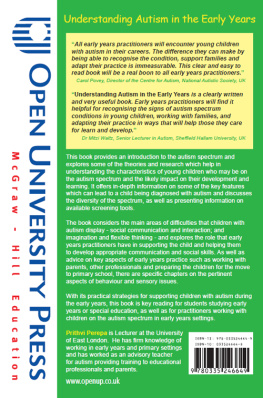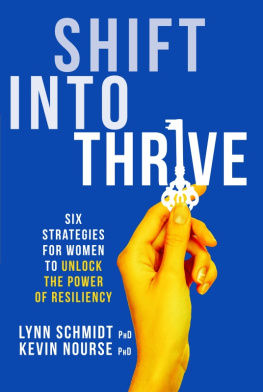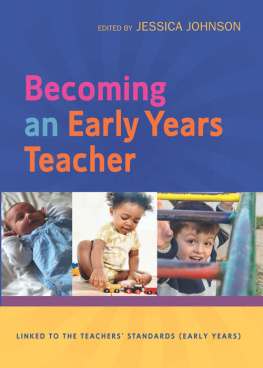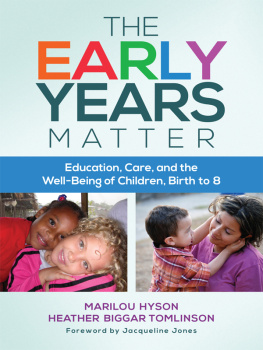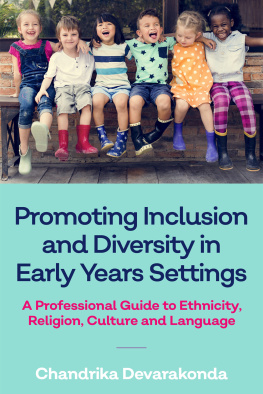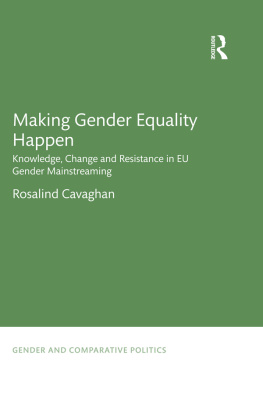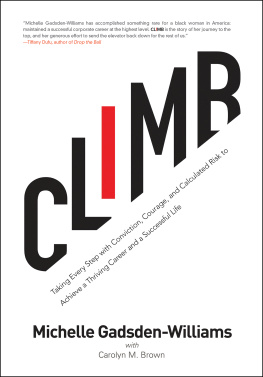
MEN IN
EARLY YEARS
SETTINGS
BUILDING A MIXED GENDER
WORKFORCE
David Wright and Simon Brownhill

Jessica Kingsley Publishers
London and Philadelphia
Contents
Glossary/Abbreviations
The following terms/abbreviations are used consistently throughout this book:
ARRD Attract, recruit, retain and develop
BaME Black, Asian, and minority ethnic
BBC British Broadcasting Corporation
BEd Bachelor of Education
BMIEY Bristol Men in Early Years (network)
CCTV Closed-circuit television
CEO Chief Executive Officer
CPD Continuing Professional Development
CWDC Childrens Workforce Development Council
CYPW Childrens and Young Peoples Workforce
DBS Disclosure and Barring Service
DfE Department for Education
DfEE Department for Education and Employment
DfES Department for Education and Skills
DoH Department of Health
DSS Department of Social Security
DUGS Dads, Uncles and Grandads
Early Years Educator Early Years practitioner holding a Level 3 Vocational Diploma for the Early Years workforce
Early Years Teacher Graduate specialist in early childhood development, holding an Early Years Teacher Status qualification
ECC Early Childhood and Care
ECCE Early Childhood Care and Education
ECE Early Childhood Education
ECEC Early Childhood Education and Care
EC-MENz The New Zealand based national network for men in early childhood education
EU European Union
EY Early Years
EYFS Early Years Foundation Stage (05 years old). The mandatory curriculum for all registered Early Years providers in England
EYPS Early Years Professional Status
FEI Further Education Institution, e.g. a college
FGP Focus Group Participant
HEFCE Higher Education Funding Council for England
HEI Higher Education Institution, e.g. a university
II Individual interviewee
IPD Initial Professional Development
ISA Independent Safeguarding Authority
ISC Independent Schools Council
ITE Initial Teacher Education
ITT Initial Teacher Training
LA Local Authority
LEYF London Early Years Foundation
LSA Learning Support Assistant
MiC Men in Childcare
MPG Major Provider Group
n.d. No date of publication indicated
NDNA National Day Nurseries Association
NVQ National Vocational Qualifications
OECD Organisation for Economic Co-operation and Development
OFSTED Office for Standards in Education, Childrens Services and Skills
PDF Portable Document Format
PHSCE Personal, Health, Social and Citizenship Education
PLEYS Professional Love in Early Years Settings
PPA Planning, Preparation and Assessment
PR Public relations
Practitioner Anyone who supports children/young people in their learning, be they a volunteer, training (student) or qualified (nursery nurse, teaching assistant, teacher)
Primary school Educational setting for children aged 511
Principals Synonym for head teachers/managers
PSED Personal, Social and Emotional Development
PVI Private, Voluntary and Independent (sector)
QA Quality Assure
Q&A Questions and answers
SAMEY Southampton Area Men in Early Years (network)
Secondary school Educational setting for young people aged 1116
SEF Setting Evaluation Form (also see SIP)
SEND Special Education Needs and Disability
SIP Setting Improvement Plan (also see SEF)
SMARTC Specific, Measurable, Achievable, Realistic, Time-related, Challenging
SMS Short Message Service
SMT Senior management team
TA Teaching Assistant
UK United Kingdom
UKS2 Upper Key Stage Two (911 years old)
USA United States of America
Introduction
DAVID WRIGHT AND SIMON BROWNHILL
Why we have written this book
As two men who have actively worked in various capacities in the Early Years sector in England over the last 14 plus years, we are conscious that we are, and continue to be, in the minority with less than 2 per cent of the workforce being male (DfE 2014), a statistic that has persisted for many decades, right up to the present day. Whilst there are a limited number of professional and academic publications exploring the numbers and profiling male practitioners in the Early Years, we know of no book that that has been written for professionals, head teachers/managers, and policy makers in the Early Years sector which critically explores new and established research findings and provides practical guidance to support those who want to not only attract men to their team but also retain and develop them.
This book explores and challenges many of the reasons attributed to the present men crisis (situation). We critically examine the evidence of media reportage, mens stories and, by conducting our own research, we gauge current public opinion. We consider the so what? of the status quo is there a case for change? If so, why? How can it be changed? Does a balanced gender workforce make a difference for children/men/families/society as a whole or should we just leave things as they are?
It is recognised and widely accepted in both public and professional discourse that the role of the adult is key to the provision of high quality Early Years care and child development (DfE 2017, p.10). It is our assertion that outcomes for children have a greater chance of being improved when they are exposed to the widest spectrum of character types across a mixed gender workforce, an area of the diversity agenda which we feel has long been untargeted in terms of policy making and implementation. If we need the nations best Early Years practitioners to nurture our youngest children during their formative years, then we should not discount potential candidates in the 50 per cent of the population that are represented by men.
In this book we explore what children need and want in terms of gender representation from their carers/educators; similarly, we critique the views of parents/carers and practitioners. Barriers to men entering and successfully working in the Early Years profession are richly illustrated by the inclusion of examples from relevant organisations and testimonials from men, women and families. We reflect on ways in which these barriers can be broken down, investigating the perceived and actual benefits of having men working with young children.
Our book asserts that nothing will change without positive action. We want to make it clear to all readers that we are not advocating discrimination we need the best people for the job regardless of gender but an honest evaluation of the facts, along with a determination to address the gender imbalance in the Early Years workforce, must be accompanied by a range of initiatives, practical strategies, approaches, tips, ideas and suggestions to encourage and support job and course applications from men, coupled with an evaluation of working practices and environments for their appropriateness for both sexes. Through this we ask and answer the following questions:
How do we create a culture in our organisation, team and in society where it is normal for children to be cared for by men and women?
In organisations where this is already the case, what are the characteristics of their culture? What has changed and what are the benefits? What actions have been taken? In other words, what does success look like and how do we replicate it or adapt it for different contexts?
How should we review our marketing, recruitment, public relations, our perceptions, expectations and beliefs about our roles and the roles of men as Early Years practitioners?
Next page
